|
|
|
Sort Order |
|
|
|
Items / Page
|
|
|
|
|
|
|
| Srl | Item |
| 1 |
ID:
128752
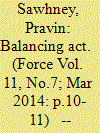

|
|
|
| 2 |
ID:
086133
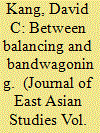

|
|
|
|
|
| Publication |
2009.
|
| Summary/Abstract |
Why has South Korea accommodated China, instead of fearing its growth and balancing against it? This article makes two central arguments. First, concepts of balancing and bandwagoning are fundamentally difficult to test, and to the extent that the theory can be tested, it appears to be wrong in the case of South Korea. In fact, we observe many cases in which rising powers are neither balanced nor "bandwagoned" but are simply accommodated with no fundamental change either way in military stance or alignment posture. Second, the factors that explain South Korean foreign policy orientation toward China are as much about interests as they are about material power. South Korea sees substantially more economic opportunity than military threat associated with China's rise; but even more importantly, South Korea evaluates China's goals as not directly threatening.
|
|
|
|
|
|
|
|
|
|
|
|
|
|
|
|
| 3 |
ID:
133314
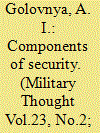

|
|
|
|
|
| Publication |
2014.
|
| Summary/Abstract |
The paper examines the issues of institutionalizing security in post soviet Russia. It offers analyses of the historical practice of establishing security related state institutions and their work.
|
|
|
|
|
|
|
|
|
|
|
|
|
|
|
|
| 4 |
ID:
053443


|
|
|
| 5 |
ID:
122158
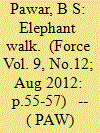

|
|
|
| 6 |
ID:
090185
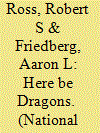

|
|
|
|
|
| Publication |
2009.
|
| Summary/Abstract |
It is past time for Americans to take seriously the challenge posed by the contining growth of China's military power. Triggered by the geopolitical shifts that accompanied the end of the cold war, fueled by the nation's repid economic growth, and driven by a mix of insecurity and ambition, today's buildup has been under way for the better part of two decades. Even before the collapse of the Soviet Union, Chinese strategists began to shift their attention from preparing for a massive, all-out "People's War against a nuclear-armed northern invader toward what they labeled" local war under high-tech conditions.
|
|
|
|
|
|
|
|
|
|
|
|
|
|
|
|
| 7 |
ID:
184928
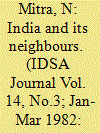

|
|
|
| 8 |
ID:
128844


|
|
|
|
|
| Publication |
2014.
|
| Summary/Abstract |
Tehran's military capabilities do not match its ambitions for recognition and status. It is cautious, defensive and prudent in resorting to force, due as much to experience as to realism about its own limits. Iran has been a source of international concern for decades. Its general hostility to the international system disturbs the regional order. Tehran's initial aim of exporting the 1979 revolution, supplanted later by exporting its revolutionary model, has caused anxiety in smaller, traditional regimes. And the view that it is a belligerent state all too ready to resort to force feeds concern about its nuclear ambitions. This perspective, largely shared by Israel and some members of the Gulf Cooperation Council, is plausible but incomplete. I will argue that by orthodox standards Iran is militarily weak, and cautious, defensive and prudent in resorting to force. This is due as much to experience as to realism about its own limits. The country does not see itself as a military power or aspire to become one, even if some of its utterances and behaviour leave room for scepticism on this point.
|
|
|
|
|
|
|
|
|
|
|
|
|
|
|
|
| 9 |
ID:
100345


|
|
|
|
|
| Publication |
2010.
|
| Summary/Abstract |
IN NORTHEAST ASIA, Russia's domestic and external interests are interconnected like in no other region. The guarantee of Russia's future as a great power lies in the economic, technological and social development of Siberia and the Far East. In regard to this vast region, the country's leadership has now set ambitious, far reaching goals whose accomplishment is to produce great results. There is no doubt that the stable development of Siberia and the Russian Far East with their natural and other resources will be comparable in its effects to the development of the West in the United States more than 100 years ago if it does not exceed them. It will, without a doubt, make an impact on all development processes both in the Asia Pacific region and outside.
The Legacy of the Cold War
THE RESOLUTION of domestic problems requires the absence of external threats. The main source of the military threat in Northeast Asia is the 60 year military confrontation on the Korean Peninsula. The Korean War started on June 25, 1950 between two Korean camps - the North, which strove to use the Soviet model for the country's unification, and the South, which committed itself to U.S. standards. In the context of the Cold War that local armed clash developed into a large scale military conflict which had almost put the world on the brink of a nuclear war. The great powers - the United States, Britain, the USSR, and China, as well as the UN, which started working on the Korean issue in 1947 and in 1950 actually became a party to the war - were directly or indirectly involved in the Korean War.
|
|
|
|
|
|
|
|
|
|
|
|
|
|
|
|
| 10 |
ID:
133634
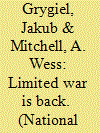

|
|
|
|
|
| Publication |
2014.
|
| Summary/Abstract |
EUROPE NEEDS to rearm and defend itself to cope with a new military threat. The American security umbrella-in both its conventional and nuclear forms-is no longer adequate, particularly on NATO's vulnerable eastern flanks. Indeed, the extended deterrent provided by the United States to its most exposed allies may not be well suited to inhibiting attacks similar to Russia's recent incursion into Ukraine, which displayed all the hallmarks of the newly popular limited conventional wars-brief and decisive, violent and yet very restrained. The purpose of such conflicts is to achieve a quick fait accompli in a geographically circumscribed area through limited force-in this case, paramilitary means followed by Russian regular forces. It is difficult to deter such a threat through the promise of retaliation, which by its very nature must occur after the facts on the ground have already been changed. A threat of retaliation is simply less credible when the enemy has achieved his objective through a low-intensity action. What are needed instead are strong local military capabilities-a preclusive defense-that increase the costs of that limited attack. Europe must start to defend its border rather than indulge in the belief that the traditional formula for deterrence, based on retaliation and the extended deterrent provided by the United States, will suffice. It won't.
|
|
|
|
|
|
|
|
|
|
|
|
|
|
|
|
| 11 |
ID:
185488


|
|
|
|
|
| Summary/Abstract |
This paper constructs a theoretical model involving supply-side effect, demand-side effect, and security effect produced by military spending to explore the effects of military spending and foreign military threat on employment. This paper proves that the relationship between defense burden and employment is nonlinear (i.e., reverse U shape.). Hence, we find the defense burden of maximizing employment. In addition, we argue that a rise in foreign military threat will be detrimental to the level of output and in turn lead to a reduction in employment. Finally, we show that an increase in the variance of the foreign military spending shocks will raise the level of output and then lead to an increase in employment.
|
|
|
|
|
|
|
|
|
|
|
|
|
|
|
|
| 12 |
ID:
139216
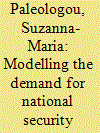

|
|
|
|
|
| Summary/Abstract |
In the past, national security for the majority of countries was almost exclusively associated with an external military threat emanating from a rival state(s). This was reflected in the standard models for the demand for military expenditure. The emergence of new security challenges such as terrorism, transnational crime networks, failed and rogue states, has profoundly affected the international security environment and the concept of national security. This note develops a model for the demand for national security expenditure adopting a broader, more inclusive definition of national security and includes concomitant budgetary outlets to meet the new security challenges.
|
|
|
|
|
|
|
|
|
|
|
|
|
|
|
|
| 13 |
ID:
073182


|
|
|
| 14 |
ID:
050372
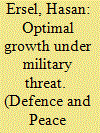

|
|
|
| 15 |
ID:
137883


|
|
|
|
|
| Summary/Abstract |
When Chief of the Army Staff (COAS), General Deepak Kapoor told his audience during a seminar in December 2009 that the Indian Army needed to build capabilities to fight a two-front war, he was merely articulating a deep-embedded obsession within the service. With two military-held lines, in the east with China and in the west with Pakistan, and the baggage of wars and crisis with both, the Indian Army has constantly been juggling with the twin threats to nation’s territorial integrity.
|
|
|
|
|
|
|
|
|
|
|
|
|
|
|
|
| 16 |
ID:
122201


|
|
|
| 17 |
ID:
084719
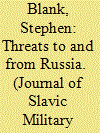

|
|
|
|
|
| Publication |
2008.
|
| Summary/Abstract |
Under conditions of visibly deteriorating Russo-American and East-West relations it is necessary to outline clearly the threats perceived by Russia from Western and U.S. policies, and second, the threats that Russia may pose in return. An analysis of such threats reveals that the balance of threat perception is asymmetrically weighted to the Russian side which perceived threats everywhere, i.e., from within and without. This underscores the fact that the baseline of Russian foreign and defense policy is the presupposition of threat, and a pervasive one at that. Second, these threats are largely perceived in terms of a classical hard power Realpolitik even if Moscow's instruments for countering them are largely nuclear weapons and its energy capabilities. Third, Russia's threat perception is extensively tied to the fear of information warfare as a tool for unhinging the entire society and state. Correspondingly, this potential, in Russia's hands, as well as its efforts to use its economic power and accompanying political instruments, are becoming the pivot of foreign perceptions of a threat originating from Russia. Finally, there is a real danger that the United States and Russia will increasingly come to see each other's military, and/or especially nuclear or missile defense forces as threats that, under conditions of ideological and political contestation, justify a new arms race.
|
|
|
|
|
|
|
|
|
|
|
|
|
|
|
|
| 18 |
ID:
115411
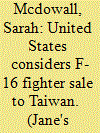

|
|
|
| 19 |
ID:
122155


|
|
|
| 20 |
ID:
122611
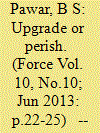

|
|
|
|
|
|
|
|